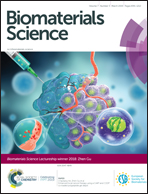Targeting mitochondria with Au–Ag@Polydopamine nanoparticles for papillary thyroid cancer therapy†
Abstract
The incidence of papillary thyroid cancer has rapidly increased in the past decade because of the progress in modern diagnostic technology. Novel therapeutic strategies for papillary thyroid cancer (which has low malignancy) based on organelle-targeted nanomaterials are greatly welcome in order to avoid over-treatment by conventional surgery. Herein, we demonstrate the mitochondria-targeted and exocytosis inhibition strategy of polydopamine (PDA)-coated inorganic nanoparticles (NPs) for enhanced papillary thyroid cancer therapy. PDA-coated gold–silver alloy NPs (Au–Ag@PDA NPs) were employed as the model of composite NPs. TPC-1 cells were chosen as the model of human papillary thyroid cancer cells. To better understand the effect of composite NPs on papillary thyroid cancer cells, the intracellular fate and corresponding cellular responses of Au–Ag@PDA NPs in TPC-1 cells were studied. The results indicate that Au–Ag@PDA NPs are internalized through a caveolae-mediated and macropinocytosis pathway and they are difficult to excrete by the TPC-1 cells. Au–Ag@PDA NPs mainly accumulate in mitochondria, resulting in the mitochondrial dysfunction and the decreased expression of dihydroorotate dehydrogenase. This leads to up-regulation of the p53 levels and therefore the S-phase cell cycle arrest and cell proliferation inhibition. In addition, despite cancer cells being able to survive by an autophagy-mediated pathway to escape apoptosis or necrosis, targeting mitochondria by Au–Ag@PDA NPs enables the destructive thermal ablation of TPC-1 cells by combination with photothermal therapy.



 Please wait while we load your content...
Please wait while we load your content...